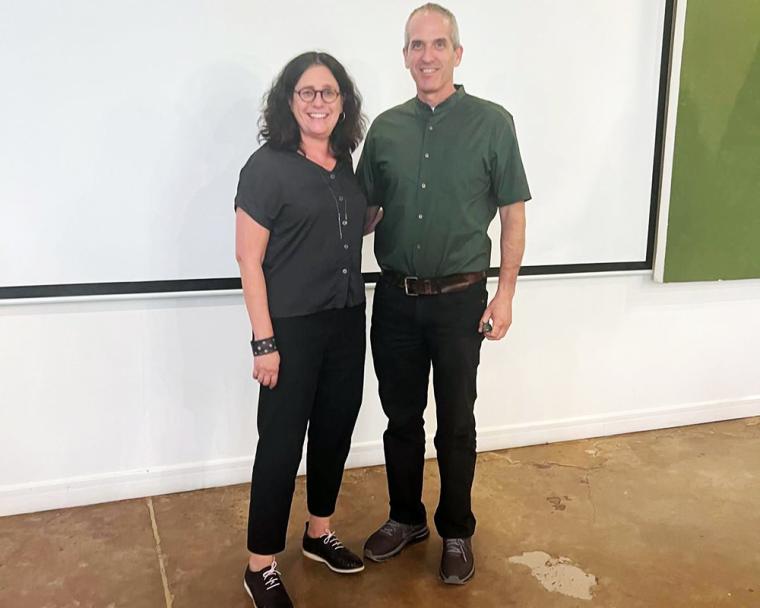Bioengineering Track Day

A scientific breakthrough in the cultured meat industry, fast and sensitive detection of the ricin toxin, and curing cancer with gold nanoparticles – these are just a few of the fascinating topics discussed in the Bioengineering Track Day
In early September, the Faculty of Engineering held a special day celebrating the bioengineering track. Faculty members honored Prof. Orit Shefi as she concluded her five-year term as head of the track, and begins a new path in October as Dean of the Faculty of Engineering. The position of head of the bioengineering track will be filled by Prof. Amos Danielli.
Throughout the day, graduate and postgraduate students from the track conducted short lectors on their research. The versatility of topics testifies to the high academic and professional level of the students and the research conducted at the Faculty of Engineering.
Shir Hartman of Dr. Yaara Erez’s lab talked about patterns of brain connectivity using recordings of electrical activity, conducted during surgery in patients with brain tumors. Great efforts are being made to map areas in the brain affiliated with different functions, to improve tumor removal precision without damaging functions. Nevertheless, there is insufficient information about how the different areas work together and create networks. Shir developed different indices for understanding connectivity and used those to characterize areas in the brain and sick and healthy tissue.
Yaron Trink of Prof. Tomer Kalisky’s lab talked about the study of gene regulation in cancerous kidney cells using single-cell level RNA analysis. Yaron uses genomic measuring of single cells to deduce how genes control each other and how this control network differs between healthy kidney tissue and cancerous tumors. Understanding this regulatory network will allow future identification of genes that play a central role in the cancerous process, and develop targeted treatment.
Zeev Cohen of Prof. Tomer Kalisky’s labtalked about alternative RNA splicing in kidney tumors. Zeev discovered a family of RNA molecules that manifest differently in invasive cancerous tumors than in the original tissue and the tumor at the pre-invasive stage. Detecting these molecules can be used in the future for early detection of the disease.
Veronica Stav Stavchansky of Prof. Amos Danielli’s lab talked about the cultured meat industry and reducing the costs of the solution in which the meat is grown. Currently, the solution is replaced once every two days, which incurs great costs. Veronica developed a quick and sensitive method for detecting the level of active agents in the solution, thereby enabling the efficient replacing of the solution, significantly reducing manufacturing costs. Her project was conducted in collaboration with Prof. Tamar Gershon’s lab at the Faculty of Life Sciences.
Eliana Levy of Prof. Amos Danielli’s lab talked about rapid and sensitive of ricin, a toxin 3,000 times stronger than cyanide – a mere 70 grams (the equivalent of 3 grains of rice) are enough to kill a person – and it can be easily produced from castor plants. The problem with ricin is that it clears quickly from the bloodstream, and the toxin cannot be determined. Eliana develop a method for detecting ricin in plasma within one hour, which she also proved to work in mice and pig plasma even 48 hours post-ingestion. Her research is done in collaboration with the Institute of Biological Research in Nes Ziona.
Noam Feldman of Dr. Shahar Alon’s lab presented an innovative technology for the spatial mapping of cerebral organoids, three-dimensional models originating in patients with rare neural diseases. Using super-resolution imaging and in-situ sequencing, Noam performs spatial RNA analysis within an entire organoid. This technology allows in-depth characterization of three-dimensional models in neurological patients, and provides a more profound understanding of reasons for disease development.
Oz Mualem of Prof. Orit Shefi’s lab is researching the impact of aging and repetitive motion on human cells, particularly the nervous system. If machines wear out over time, how is it that our bodies continue to function for years? Oz develops advanced microscopic methods for analyzing microtubule structure – which make up the cytoskeleton – to examine the effects of motion on cells and identifying rehabilitative mechanisms.
Sammy Apsel of Dr. Nisan Ozana’s lab is researching Rolling Shutter-based methods for measuring acoustic phenomena at kHz rhythms. By moving from the temporal to spatial dimension, one can use cameras with low framerates of 30–60 Hz and measure changes to blood flow at kHz rhythms. This technique can be useful in many applications in cardiology and neurophotonics.
Shir Hochwald-Liber of Prof. Rachela Popovtzer’s lab is developing a synthetic biology-based biochip for immediate noninvasive detecting and monitoring bowel diseases. Shir developed an innovative technology that combines bacterial biosensors and advanced electronic systems to allow for high-precision detection and monitoring of various medical states. The system has thus far proven capable of detecting and monitoring inflammatory bowel diseases based on precise electrical signals which are received by the system and point to the nature and condition of the disease. This new technology will be used as a diagnostic tool for easily detecting and monitoring a variety of conditions and enable personalized medicine, utilizing the system’s information to generate tailored treatment for each patient and their unique condition.
Adi Anaki of Prof. Rachela Popovtzer’s lab is developing tools for the efficient and targeted elivery of drugs to cancerous tumors. Adi achieves this by using antibody-coated gold nanoparticles, which have an advantage in cancer treatment due to clustering inside the tumor and reducing side effects. Adi examined how changes in antibody binding – such as covalent bonds and physical adsorption – affect the anti-cancer functionality of the particles, and found that covalent bonds significantly increased cancer cell death. At a later stage, Adi bound two antibodies to bispecific GNPs, proving that not only are these particles more efficient than a combination of free antibodies, they also trigger the immune system to destroy cancer cells.
In the picture: Prof. Orit Shefi (left) and Prof. Amos Danielli (right).
Last Updated Date : 01/10/2024



